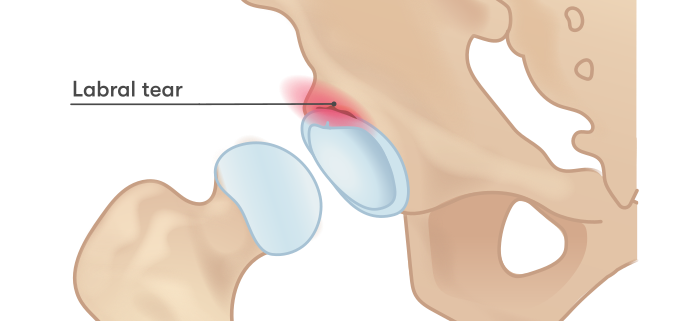
Labral Tears of the Hip
Overview
A labral tear of the hip is a condition characterized by damage to the ring of cartilage (labrum) that follows the outside rim of your hip joint socket. The hip joint consists of a ball and socket, where the ball is the femoral head (top of your thigh bone), and the socket is made of pelvic bone. The labrum acts like a rubber seal or gasket to provide stability, yet also allows flexibility and motion within the joint. When this cartilage becomes torn, it can lead to pain, discomfort, and reduced mobility. Labral tears can affect anyone, but are more common among athletes or individuals who perform repetitive twisting or pivoting movements.
Types
There are no apparent subtypes for labral tears, but the condition itself can vary in severity. The tear can either be minor, with the labrum remaining in place, or it could be more severe, causing the labrum to become displaced or flap.
Causes
Labral tears are often caused by:
-
- Trauma: Injuries to the hip, or a fall, can lead to a labral tear.
-
- Structural abnormalities: Some people are born with hip problems that can cause a gradual breakdown of the labrum.
-
- Repetitive motion or overuse: Athletes who participate in sports that involve a lot of twisting and turning, such as basketball or golf, are at higher risk.
-
- Osteoarthritis: This condition can cause wear and tear on the hip joint and the labrum, leading to a tear.
Symptoms
Common symptoms of a labral tear include:
-
- Hip pain, often located in the groin area
-
- A clicking, catching, or locking sensation in your hip
-
- Reduced range of motion
-
- Stiffness or instability of the hip
In some cases, patients may not experience any symptoms.
Diagnosis
Diagnosis usually begins with a physical examination and discussion of your symptoms. Various imaging tests can also be used to diagnose a labral tear of the hip, such as X-rays, magnetic resonance imaging (MRI), or ultrasound. In certain cases, doctors may also use a technique known as arthroscopy, where a small camera is inserted into the joint to inspect it directly.
Treatment Options
Treatment for a labral tear of the hip can vary with the severity of the condition. For minor tears, non-surgical approaches may be sufficient:
-
- Physical therapy: An exercise program can improve joint mobility and strengthen the hip muscles.
-
- Non-steroidal anti-inflammatory drugs (NSAIDs): Over-the-counter medicines like ibuprofen can alleviate pain and inflammation.
-
- Lifestyle changes: Weight loss, changes to activity levels, or using assistive devices can help manage symptoms.
In more severe cases, surgery may be necessary to repair the torn labrum.
Living With Labral Tears of the Hip
Living with a labral tear can be challenging, but with the right management and care, patients can lead normal and active lives. Managing the condition can include regular physical therapy, staying active, making dietary changes to maintain a healthy weight, and taking prescribed medication as recommended by your healthcare provider.
When to Seek Help
While minor pain or discomfort may be common, seek immediate medical attention if you experience severe hip pain, can’t put weight on the affected leg, or if your symptoms worsen despite treatment. An early diagnosis is key to preventing further damage and ensuring effective treatment.
Remember, it’s crucial to communicate openly with your healthcare provider about your symptoms and any changes in your condition to achieve the best possible outcome.
